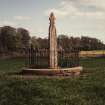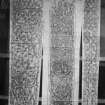Thornhill, Nith Bridge, Cross
Cross (Early Medieval)
Site Name Thornhill, Nith Bridge, Cross
Classification Cross (Early Medieval)
Canmore ID 65198
Site Number NX89NE 6
NGR NX 86890 95471
Datum OSGB36 - NGR
Permalink http://canmore.org.uk/site/65198
- Council Dumfries And Galloway
- Parish Penpont
- Former Region Dumfries And Galloway
- Former District Nithsdale
- Former County Dumfries-shire
Thornhill, Nith Bridge, Dumfriesshire, cross
Measurements: H 2.74m, shaft W 0.33m-0.43m, D 0.20m
Stone type: reddish sandstone
Place of discovery: NX 86890 95471
Present location: standing in an enclosure in a field at NX 86890 95471, close to the modern road and near Nith Bridge.
Evidence for discovery: first recorded by Robert Riddell in 1793, apparently still in its original base and in its original location.
Present condition: very weathered and lacking its side-arms and much of its top arm. Face C is very damaged towards the top.
Description
A tall and once elegant cross, much detail of the carving has been lost. It is carved in relief on all four faces, outlined with a double roll moulding, and the surviving lower cross-arm has a double-cusped shape. Face A, the east face, is the best preserved and shows a large encircled rosette filling the centre of the cross-head, with 13 petals around a small central boss. Within the double moulding the shaft is divided into five panels separated by horizontal mouldings. The top panel contains a pair of confronted bipeds with entwined legs, the next panel two pairs of long-tailed bipeds, the next a pair of upright quadrupeds, next a pair of winged bipeds and finally a pair of prancing winged bipeds.
Narrow face B (the north face) is carved as one long panel with a continuous chain of interlocked animals.
Broad face C (the west face) may have had five panels of ornament but only the lower three have survived the weathering. They are separated by arched mouldings and each contains a pair of confronted and enmeshed animals.
Narrow face D (the south face) bears a single long panel of open interlace.
Riddell describes the base as stepped, but only the top is now visible.
Date: eighth or ninth century.
References: Riddell 1793, 131-3; Stuart 1856, pl 121; ECMS pt 3, 449-50; RCAHMS 1920, no 531; Craig 1992, vol 2, 12-24 (Boatford 1).
Desk-based information compiled by A Ritchie 2019.
NX89NE 6 8689 9546.
(NX 8689 9546) Cross (NR)
OS 6" map (1957)
This free standing cross of pink sandstone, situated in a field and surrounded by a railing, is 9' in height and 17" x 8" at base. Its shaft is richly carved on all sides with zoomorphic and foliaceous interlaced work. A late 9th (4) or 10th (5) century date is suggested for it.
J R Allen and J Anderson 1903; RCAHMS 1920, visited 1912; A W Clapham 1942; G W Collingwood 1926
Field Visit (10 June 1912)
In a field and surrounded by an iron railing, some 200 yards west of the Nith Bridge and 20 yards south of the road from Penpont to Thornhill, stands a cross of led sandstone (fig. 129) 9 feet in height above ground, 17 inches broad at base, 13 inches at top of shaft, 8 inches in thickness. The length of the shaft is 6 feet 6 inches. The shaft on all sides is richly carved with zoomorphic and foliageous interlaced work. The cross is fully described in Early Christian Monuments, pp. 449-450, from which the drawings in fig. 129 have been reproduced. It is much covered with lichen, and in consequence the ornament is difficult to follow.
Visited by RCAHMS, 10 June 1912.
Field Visit (5 June 1975)
As described.
Visited by OS (SFS) 5 June 1975
Publication Account (1986)
Next to Ruthwell, this is the most complete Anglian sculptured cross in the region. Standing to an overall height of 2.7m, it remains intact except for the top and side-arms of the cross-head and may occupy its original position. The cross-head had double concave 'arm-pits' with a flat central rosette. The faces are made up of zoomorphic-carved panels, including paired and winged beasts, while the narrow sides bear continuous variegated plait decoration.
Information from ‘Exploring Scotland’s Heritage: Dumfries and Galloway’, (1986).






















